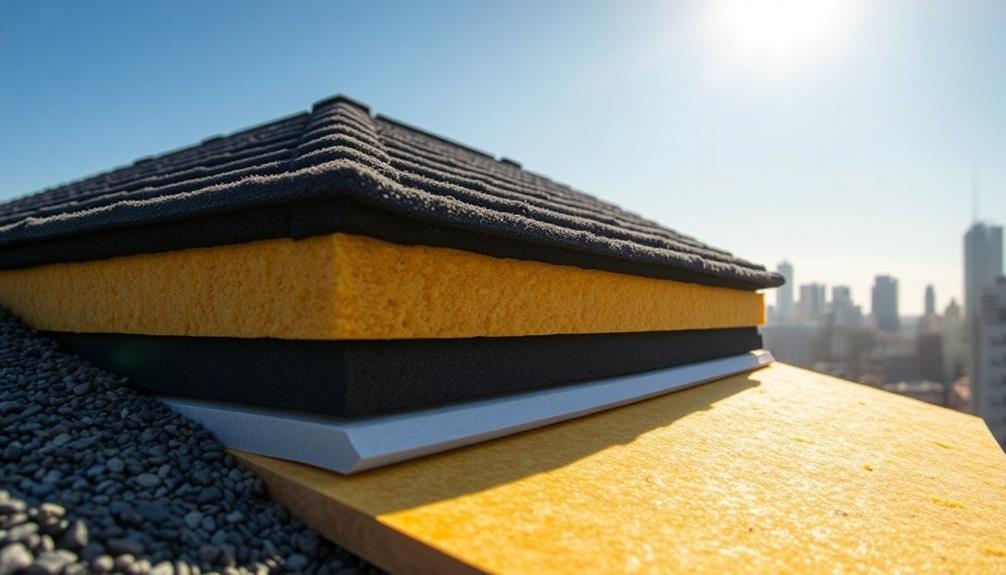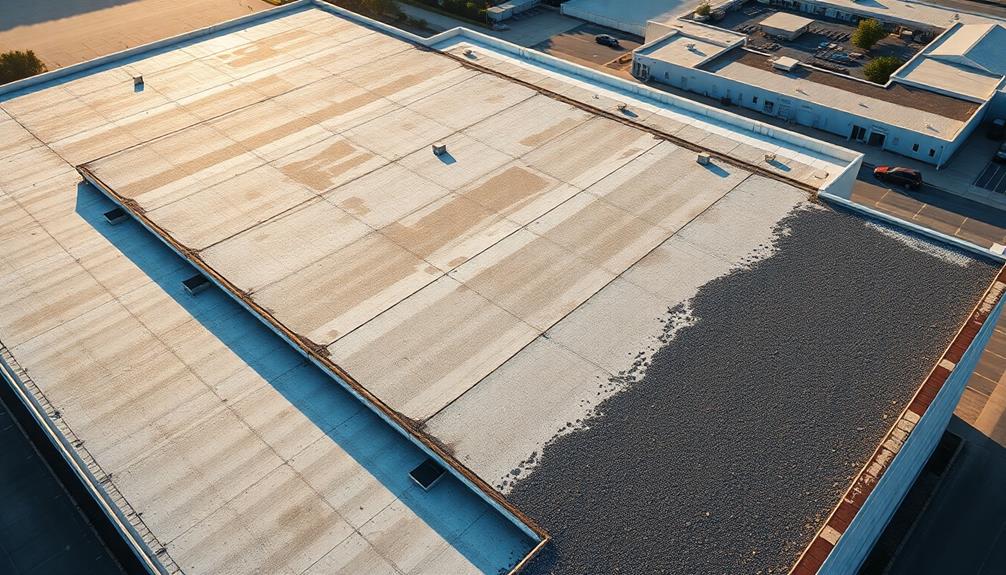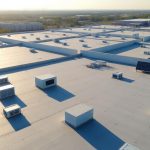Built-up roofing (BUR) systems are robust, multi-layered commercial roofing solutions that provide superior waterproofing and durability. These systems consist of alternating layers of bitumen and reinforcing fabrics, creating a continuous, sealed membrane. The installation process involves careful application of a base sheet, followed by successive layers of felts and bitumen, culminating in a protective cap sheet or aggregate surfacing. BUR systems offer exceptional resistance to harsh weather conditions, water intrusion, and UV radiation, with lifespans ranging from 15 to 40 years when properly maintained. Their customizable nature allows for tailored solutions to meet specific building requirements and climate conditions. Further exploration of BUR systems reveals additional benefits and applications for commercial properties.
Roofing Highlights
- Built-Up Roofing (BUR) systems consist of multiple layers of reinforcing felts and bituminous materials, creating a robust waterproof membrane.
- The layered construction process involves careful installation of a base sheet followed by successive layers of felts and bitumen.
- BUR systems offer superior waterproofing capabilities, able to withstand over 100 inches of water without leaking.
- These systems can be customized with various insulation options and aggregate surfacing to meet specific project requirements.
- With proper installation and maintenance, BUR systems can last 15 to 40 years, providing long-term protection against harsh weather conditions.
Bur’s Layered Construction Process

Our expert roofing team specializes in the installation and maintenance of Built-Up Roofing (BUR) systems, offering superior protection for commercial and industrial buildings. We meticulously apply multiple layers of reinforcing felts and bituminous materials, creating a robust, waterproof membrane that outperforms single-ply alternatives. Our highly-skilled professionals are committed to delivering affordable rates and ultimate quality, guaranteeing customer satisfaction as our top priority.
Our process begins with the careful installation of a base sheet, followed by successive layers of felts and bitumen, and culminates with a protective cap sheet. This layered approach safeguards maximum durability and weather resistance, providing our clients with a long-lasting roofing solution that stands up to harsh environmental conditions. We use high-quality materials and adhere to industry best practices, assuring a roof that not only meets but exceeds expectations for waterproofing and UV protection.
Multiple Ply Membrane Assembly
The intricacy of built-up roofing systems lies in their layered construction process, known as multiple ply membrane assembly. This sophisticated roofing technique involves the meticulous application of multiple layers, each serving a specific purpose in creating a robust and long-lasting BUR system. The process begins with the installation of a base sheet, which forms the foundation of the roof’s waterproofing capabilities.
Following the base sheet, the BUR system’s core is constructed through the alternating application of:
- Bitumen layers, typically asphalt-based
- Reinforcing fabrics or felts
- Insulation boards for enhanced thermal performance
- Additional bitumen and fabric layers
- A protective surfacing material
This carefully orchestrated layering process results in a cohesive and continuous sealed surface, providing superior protection against the elements. The multiple ply membrane assembly allows for customization based on specific building requirements, climate conditions, and desired performance characteristics. By incorporating various materials and adjusting the number of layers, roofing professionals can tailor the BUR system to meet the unique needs of each project, ensuring ideal durability and functionality for years to come.
Hot Bitumen Application Technique
At the heart of built-up roofing systems lies the hot bitumen application technique, a critical process that defines BUR’s layered construction. This method involves the meticulous application of hot asphalt, also known as bitumen, to create a robust and waterproof membrane. The built-up roofing system is characterized by its multiple layers of asphalt, each carefully applied to guarantee a strong bond with the underlying substrate and reinforcing materials.
The process begins with the hot-mopping or torch-application of bitumen onto the roof deck. Subsequent layers are then added, typically consisting of 3-5 plies, resulting in a minimum of 4 layers of protection. Each layer of bitumen is applied with precision, creating a continuous, sealed surface that forms the foundation of BUR systems.
The final step in this layered construction process involves the application of a top layer, often comprising a mineral-surfaced cap sheet or a flood coat of bitumen topped with gravel. This essential finishing touch provides additional protection against UV exposure and weathering, further enhancing the durability and longevity of the roof assembly.
Aggregate Surfacing Options
Various aggregate surfacing options play an essential role in completing the layered construction process of built-up roofing (BUR) systems. These systems, primarily used for flat or low-slope roofs, rely on a top layer of aggregate to provide vital protection against environmental elements.
The final surfacing not only shields the underlying asphalt and felts from UV exposure but also enhances the overall durability and performance of the BUR system.
When selecting aggregate surfacing options for BUR roofing, contractors and building owners can choose from:
- Smooth-surfaced mineral-cap sheets
- Flood coats of asphalt with embedded gravel
- Combination of mineral-cap sheets and gravel
- Reflective, white-colored roof granules for improved energy efficiency
- Custom aggregate blends to meet specific project requirements
The chosen surfacing material must be properly installed and maintained to guarantee ideal weatherproofing capabilities. Reflective options, such as white-colored granules, can drastically improve a building’s energy efficiency by reducing heat absorption. This aligns with cool roof standards and can provide long-term cost savings for building owners.
Ultimately, the selection of an appropriate aggregate surfacing is indispensable for maximizing the lifespan and performance of BUR systems, making it an essential consideration in the roofing process.
Benefits

Built-up roofing systems offer a trifecta of benefits that make them an excellent choice for commercial and industrial buildings. The long-lasting durability of these systems, with their multiple layers of ply sheets and asphalt, provides exceptional resistance to weathering and foot traffic, often lasting for decades with proper maintenance.
Commercial roofing experts can evaluate the best built-up roofing system for your specific needs, ensuring ideal performance and longevity. Their excellent waterproofing properties stem from the redundant nature of the system, creating a nearly impenetrable barrier against moisture infiltration, while the customizable insulation options allow for tailored energy efficiency solutions to meet the specific needs of each building and climate.
Long-Lasting Durability
Roofing systems that stand the test of time are invaluable for building owners, and built-up roofing (BUR) systems exemplify this quality. With over a century of proven performance, BUR systems offer exceptional durability and protection for commercial structures. These roofs, composed of multiple layers of ply sheets and hot asphalt materials, create a redundant barrier against water infiltration and weathering.
The longevity of BUR systems is further enhanced by:
- Potential lifespan of up to 40 years with suitable maintenance
- Excellent resistance to harsh weather conditions
- Eligibility for long-term guarantees and warranties up to 20 years
- Adaptability with reflective White-coated cap sheets for improved energy efficiency
- Multi-layered construction providing superior protection for the roof deck
This remarkable durability guarantees that building owners can rely on their BUR system for decades, minimizing the need for frequent replacements and reducing long-term costs. The multiple layers of protection offer peace of mind, knowing that the structure is shielded from the elements by a time-tested roofing solution. With proper care and maintenance, BUR systems continue to be a dependable choice for those seeking a long-lasting, high-performance roofing solution.
Excellent Waterproofing Properties
When it comes to protecting buildings from water infiltration, built-up roofing (BUR) systems excel due to their exceptional waterproofing properties. These membrane roof systems are designed to provide superior resistance to water, making them ideal for low-slope or flat roofs where water pooling can be a significant concern.
The multi-layered structure of BUR systems, typically consisting of a base sheet, multiple ply sheets, and a flood coat of asphalt, creates a redundant and highly effective barrier against moisture intrusion.
The exceptional waterproofing capabilities of BUR systems are evidenced by their ability to withstand extreme water exposure. Studies have demonstrated that properly installed BUR systems can endure over 100 inches of water without leaking, showcasing their remarkable resilience in the face of challenging environmental conditions.
This impressive performance is attributed to the continuous seal formed by the overlapping layers of bitumen and reinforcement felts. As a result, building owners and facility managers can trust in the long-term protection provided by BUR systems, ensuring that their structures remain dry and secure even in the most demanding weather conditions.
Customizable Insulation Options
One of the most significant advantages of built-up roofing systems lies in their customizable insulation options. These options allow for maximizing thermal performance based on climate, building requirements, and budgetary constraints. The versatility of insulation choices enables architects and contractors to tailor solutions that meet specific project needs while enhancing energy efficiency and fire resistance.
Built-up roofing systems offer a range of insulation materials, each with unique benefits:
- Polyisocyanurate (polyiso) insulation boards: High R-values and moisture resistance
- Perlite-based insulation boards: Economical thermal and fire protection
- Gypsum-based cover boards: Exceptional fire resistance and wind uplift performance
- Dual-density polyiso composite boards: Versatile option combining high-density surface protection with standard-density foam core
- Customizable layering: Ability to combine different insulation types for ideal performance
BUR Lifespan and Durability

Built-up roofing (BUR) systems are renowned for their exceptional longevity, with lifespans ranging from 15 to 40 years depending on various factors. The durability of these systems is largely attributed to their multi-layered construction, which provides superior weather resistance and protection against the elements. Regular maintenance plays a pivotal role in maximizing the lifespan and performance of BUR systems, ensuring they continue to deliver ideal results throughout their service life.
| Factor | Impact on BUR Lifespan |
|---|---|
| Climate | High |
| Maintenance | Critical |
| Materials Quality | Significant |
| Installation | Essential |
| Roof Traffic | Moderate |
Longevity of BUR Systems
Consistently ranking among the most durable roofing options, built-up roofing (BUR) systems have an impressive lifespan of 15 to 40 years. This exceptional longevity is attributed to the redundant nature of multiple plies, which provide superior weather resistance and durability. BUR systems excel in protecting flat roofs and high traffic areas, making them ideal for commercial and industrial buildings.
The enduring performance of BUR systems is evident in their century-long use in the United States. To maximize their lifespan, proper maintenance and timely repairs are essential. Additionally, applying protective coatings can extend the system’s durability much longer than its initial expected lifespan.
Key factors contributing to BUR longevity include:
- Multiple layers of asphalt and reinforcing fabric
- Resistance to ponding water and heavy foot traffic
- Ability to withstand challenging rooftop conditions
- Highly reflective coatings for improved heating and cooling efficiency
- Adaptability to various climate zones
BUR systems continue to be a preferred choice for building owners seeking a long-lasting, reliable roofing solution. Their proven track record and ability to endure severe weather conditions make them an excellent investment for those prioritizing durability and performance in their roofing systems.
Weather Resistance Factors
A key factor contributing to the impressive longevity of built-up roofing (BUR) systems is their exceptional weather resistance. These high-performance roofing solutions have demonstrated their ability to withstand extreme weather conditions and heavy rainfall, with many installations lasting 20-30 years or more when properly maintained. The multi-layered structure of BUR systems, comprising alternating layers of asphalt and felt, creates a robust and waterproof membrane that offers exceptional resistance to the elements.
Advanced asphalt formulations and protective surfacing options, such as reflective mineral granules, further enhance the weather resistance and energy efficiency of BUR systems. Proper installation techniques, including secure fastening and appropriate slope, are critical for ensuring long-term water shedding and mitigating issues like ponding that can accelerate roof deterioration.
To maximize the weatherproofing capabilities and lifespan of a BUR system, regular inspections and timely maintenance are essential. This includes repairing blisters or cracks as they occur, ensuring the roof continues to perform at its peak. By adhering to these best practices, building owners can rely on their BUR systems to provide superior protection against harsh weather conditions for decades.
Maintenance Impact on Durability
How does maintenance impact the durability of built-up roofing (BUR) systems? Regular maintenance is vital for maximizing the lifespan and durability of BUR systems, which can last 15-40 years depending on the materials and care provided. Proper maintenance reduces the number of potential issues and guarantees the continuous protection of underlying roof components. When the top layer is damaged, prompt repairs are essential to prevent further deterioration.
To maintain a BUR system effectively, building owners should:
- Conduct regular inspections
- Clean the roof surface
- Address ponding, cracks, or blisters promptly
- Consult experienced roofing professionals for guidance
- Tailor maintenance strategies to the specific property and climate
Neglecting maintenance or delaying repairs can lead to accelerated deterioration and costly replacements. Factors such as location, climate, and building usage impact the required maintenance frequency and expected lifespan. By adhering to an extensive maintenance plan, building owners can ensure their BUR system maintains its UL Class rating and continues to provide added protection for years to come. Consulting with roofing experts helps in making informed decisions about maintenance and repair strategies, ultimately extending the service life of the roof.
Connect With Us
Take the Next Step in Superior Roofing
Ready to experience the Karnak difference in built-up roofing systems? Our team of experts is standing by to provide you with personalized solutions and unparalleled support.
Whether you’re a contractor looking for top-quality products or a building owner seeking durable roofing solutions, we’re here to help. For additional resources and ARCM information, visit our dedicated page to learn more about our company and services.
Don’t settle for anything less than the best. Call us today at (303) 306-8384 to discuss your roofing needs, learn more about our Q Applicator Program, or schedule a consultation. Let Karnak’s 90 years of roofing expertise work for you.
Roofing FAQ
What Is a Built-Up Roofing System?
A built-up roofing system is a reliable, multi-layered roofing solution for low-slope or flat roofs. It consists of alternating layers of ply sheets and asphalt, topped with a protective cap sheet or granule-embedded flood coat, providing exceptional weather resistance.
What Are the Pros and Cons of Built up Roofing?
Built-up roofing offers excellent weatherproofing and durability, with a long lifespan and adaptability. However, it can be challenging to install, potentially messy, and difficult to repair. Consider your building’s specific needs when weighing these pros and cons.
How Many Layers Does a Built-Up Roof Have?
A built-up roof typically consists of 3 to 5 layers, including a base sheet, multiple plies of reinforcing felts, and a top layer. This multi-layered structure enhances durability and waterproofing, providing reliable protection for our buildings.
How Is a Built-Up Roof Installed?
A built-up roof is installed by first mechanically fastening a base sheet, then applying alternating layers of hot asphalt and ply sheets. A cap sheet is added, and sometimes a flood coat with gravel for enhanced protection.




